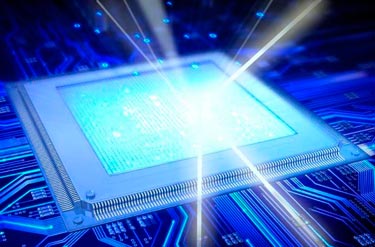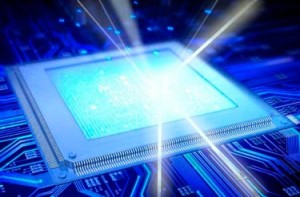NAWCAD Demonstrates Laser Computing Concept

 A recent demonstration by scientists at the Naval Air Warfare Center Aircraft Division used light particles, instead of electricity, to transfer and process information. The technology could be used to significantly reduce power consumption while providing more electronic capabilities.
A recent demonstration by scientists at the Naval Air Warfare Center Aircraft Division used light particles, instead of electricity, to transfer and process information. The technology could be used to significantly reduce power consumption while providing more electronic capabilities.
The process involves placing a Highly Integrated Photonics network on a chip made from Germanium, a lustrous, hard, grayish-white metalloid in the carbon group, chemically similar to tin and silicon. The isolated element is a semiconductor, with an appearance similar to elemental silicon.
The Germanium laser technology was achieved under a NAWCAD contract led by project manager Chuck Caposell, who initiated the effort and managed the research from its inception.
The initial Fully Laser Integrated Photonics (FLIP) effort consisted of demonstrating a Germanium laser as its main goal but also included other aspects of the design and development of the next generation of multi-core processor chips optically interconnected.
The team that conducted this research and development for the Navy included APIC Corporation as the prime contractor with MIT and Stanford University as sub-contractors.
Creating a silicon-compatible light source such as Germanium on the semiconductor has been a key missing piece for economical mass manufacturing of photonic semiconductor chips. Photonic chips use particles of light instead of electricity to transfer and process information, consuming much less power while producing much more capability compared to electronics. Because silicon is the base material for the worldwide semiconductor industry, if the light source is not silicon-compatible, the chip cannot be manufactured economically in mass production. Germanium is compatible with silicon and is an element commonly used in semiconductors.
While there is much work to do, the computer industry could feel the first effects of this opportunity. The explosion in bandwidth requirements and data centers worldwide has resulted in enormous amounts of energy needed to satisfy the demand of power-hungry electronic processors. Photonic chips use a fraction of the power currently needed because photons do not generate heat. Much of the cooling needed in computers and data centers also would be unnecessary, cascading the savings effect on the energy needed. Along with the energy savings, optical data communications networks provide massive increases in processor speed and computational capabilities.
Source: NAWCAD Public Affairs























